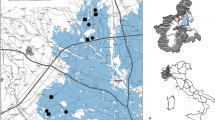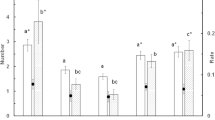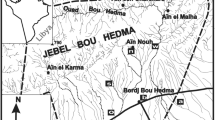Abstract
Our study showed that one species of water strider (Aquarius najas) dominated the insect fauna (>90% of the biomass) on and near the surface of a small stream in southern Sweden, but the diet of Daubenton's bats (Myotis daubentonii), regularly feeding over the same stream, contained <1% of these insects. To explain why the bats did not eat water striders in proportion to the apparent abundance of these insects, we tested three hypotheses, with the following results: (1) The water striders did not respond to artificial bat calls and therefore their defence against bats is not based on ultrasonic hearing. (2) Water striders hand-fed to the bats were eaten with similar frequency as palatable controls (caddis flies), so there is no evidence that water striders are unpalatable to bats. (3) Attempted prey-captures by the bats occurred less often than expected within 1 m of the bank of the stream (the bank consisted of a stone wall), indicating that the bats' flight or, alternatively, their detection or capture of insects, was difficult within that area, possibly constrained by clutter. At dusk and just before the bats emerged to feed, the water striders moved away from the open water. They remained motionless close to the bank for as long as the bats were active.
Similar content being viewed by others
References
Andersen, N. M., 1982. The Semiaquatic Bugs (Hemiptera, Gerromorpha). Phylogeny, adaptations, biogeography and classification. Entomonograph 3: 1–455.
Andersen, N. M., 1996. Heteroptera Gerromorpha, Semiaquatic bugs. In Nilsson, A. (ed.), Aquatic Insects of North Europe. A Taxonomic Handbook. Vol. I. Apollo Books, Svendrup, Denmark: 77–90.
Anthony, E. L. P. & T. H. Kunz, 1977. Feeding strategies of the little brown bat, Myotis lucifugus, in New Hampshire. Ecology 58: 775–786.
Barclay, R. M. R. & R. M. Brigham, 1994. Constraints on optimal foraging: a field test of prey discrimination by echolocating insectivorous bats. Anim. Behav. 48: 1013–1021.
Beck, A., 1995. Fecal analyses of European bat species. Myotis 32– 33: 109–119.
Belwood, J. J. & M. B. Fenton, 1976. Variation in the diet of Myotis lucifugus (Chiroptera: Vespetilionidae). Can. J. Zool. 54: 1674–1678.
Boonman, A. M., M. Boonman, F. Brettschneider & W. van de Grind, 1998. Prey detection in trawling insectivorous bats: duckweed affects hunting behaviour in Daubenton's bat, Myotis daubentonii. Behav. Ecol. Sociobiol. 44: 99–107.
Fenton, M. B. & G. P. Bell, 1979. Echolocation and feeding behaviour in four species of Myotis (Chiroptera). Can. J. Zool. 57: 1271–1277.
Forrest, T. G., H. E. Farris & R. R. Hoy, 1995. Ultrasound acoustic startle response in scarab beetles. J. Exp. Biol. 198: 2593–2598.
Frenckell, B. von & R. M. R. Barclay, 1987. Bat activity over calm and turbulent water. Can. J. Zool. 65: 219–222.
Griffin, D. R., F. A. Webster & C. R. Michael, 1960. The echolocation of flying insects by bats. Anim. Behav. 8: 141–154.
Jones, G. & J. M. V. Rayner, 1988. Flight performance, foraging tactics and echolocation in free-living Daubenton's bats Myotis daubentonii (Chiroptera: Vespertilionidae). J. Zool. Lond. 215: 113–132.
Kalko, E. K. V. & H.-U. Schnitzler, 1989. The echolocation and hunting behavior of Daubenton's bat, Myotis daubentoni. Behav. Ecol. Sociobiol. 24: 225–238.
Kalko, E. K. V. & H.-U. Schnitzler, 1993. Plasticity in echolocation signals of European pipistrelle bats in search flight: implications for habitat use and prey detection. Behav. Ecol. Sociobiol. 33: 415–428.
Krupa, J. J. & A. Sih, 1998. Fishing spiders, green sunfish, and a stream-dwelling water strider: male–female conflict and prey responses to single versus multiple predator environments. Oecologia 117: 258–265.
Lewis, F., J. H. Fullard & S. B. Morrill, 1993. Auditory influences on the flight behaviour of moths in a Neartic site. II. Flight times, heights and erraticism. Can. J. Zool. 71: 1562–1568.
Mackey, R. L. & R. M. R. Barclay, 1989. The influence of physical clutter and noise on the activity of bats over water. Can. J. Zool. 67: 1167–1170.
Miller, L. A. & J. Olesen, 1979. Avoidance behavior in green lacewings. I. Behavior of free flying green lacewings to hunting bats and ultrasound. J. Comp. Physiol. 131: 113–120.
Nilsson, A. (ed.), 1996. Aquatic Insects of North Europe. A Taxonomic Handbook. Vol. I. Apollo Books, Svendrup, Denmark.
Nilsson, A. (ed.), 1997. Aquatic Insects of North Europe. A Taxonomic Handbook. Vol. II. Apollo Books, Svendrup, Denmark.
Nyholm, E., 1965. Zur Ökologie von M. mystacinus (Leisl.) und M. daubentoni (Leisl.) (Chiroptera). Ann. Zool. Fenn. 2: 77–123.
Roeder, K. D., 1967. Nerve Cells and Insect Behavior, 2nd revised edn. Harvard Univ. Press, Cambridge, MA.
Rydell, J., 1986. Foraging and diet of the northern bat Eptesicus nilssoni in Sweden. Holarc. Ecol. 9: 272–276.
Rydell, J., 1998. Bat defence in lekking ghost swifts (Hepialus humuli), a moth without ultrasonic hearing. Proc. r. Soc. Lond. B 265: 1373–1376.
Rydell, J., A. Bushby, C. C. Cosgrove & P. A. Racey, 1994. Habitat use by bats along rivers in north-east Scotland. Folia Zool. 43: 417–424.
Rydell, J., L. A. Miller & M. E. Jensen 1999. Echolocation constraints of Daubenton's bat foraging over water. Funct. Ecol. 13: 247–255.
Rydell, J., N. Skals, A. Surlykke & M. Svensson, 1997. Hearing and bat defence in geometrid winter moths. Proc. r. Soc. Lond. B 264: 83–88.
Scrimshaw, S. & W. C. Kerfoot, 1987. Chemical defences of freshwater organisms: beetles and bugs. In Kerfoot, W. C. & A. Sih (eds), Predation & Direct and Indirect Impacts on Aquatic Communities. University Press of New England, Hanover and London: 240–262.
Shiel, C., C. McAney, C. Sullivan & J. Fairley, 1997. Identification of Arthropod Fragments in Bat Droppings.Mammal Society, London.
Speakman, J. R. & J. Rydell, 2000. Avoidance behaviour in bats and insects: when is it predator defence? Oikos 88: 221–223.
Staddon, B. W., 1979. The scent glands of Heteroptera. Adv. Insect Physiol. 14: 352–418.
Sullivan, C. M., C. B. Shiel, C. M. McAney & J. S. Fairley, 1993. Analysis of the diet of Leisler's Nyctalus leisleri, Daubenton's Myotis daubentonii and pipistrelle, Pipistrellus pipistrellus bats in Ireland. J. Zool. Lond. 231: 656–663.
Swift, S. M. & P. A. Racey, 1983. Resource partitioning in two species of vespertilionid bats (Chiroptera) occupying the same roost. J. Zool. Lond. 200: 249–259.
Swift, S. M., P. A. Racey & M. I. Avery, 1985. Feeding ecology of Pipistrellus pipistrellus (Chiroptera: Vespertilionidae) during pregnancy and lactation. II. Diet. J. Anim. Ecol. 54: 217–225.
Taake, K-H., 1992. Strategien der Ressourcennutzung an waldgewässern jagender Fledermäuse (Chiroptera: Vespertilionidae). Myotis 30: 7–74.
Wallin, L., 1961. Territorialism on the hunting grounds of Myotis daubentoni. Säugetierkundlische Mitteilungen 9: 156–159.
Yager, D. D. & R. R. Hoy, 1986. The cyclopean ear: a new sense for the praying mantis. Science 231: 727–729.
Author information
Authors and Affiliations
Corresponding author
Rights and permissions
About this article
Cite this article
Svensson, A.M., Danielsson, I. & Rydell, J. Avoidance of bats by water striders (Aquarius najas, Hemiptera). Hydrobiologia 489, 83–90 (2002). https://doi.org/10.1023/A:1023254503466
Issue Date:
DOI: https://doi.org/10.1023/A:1023254503466




